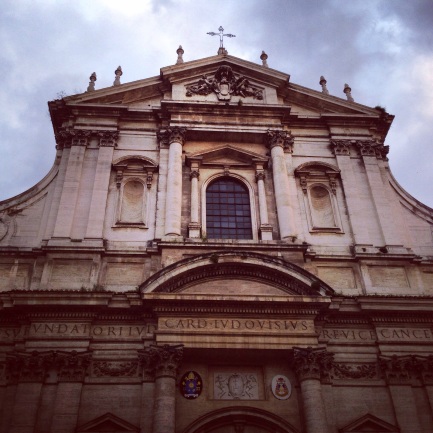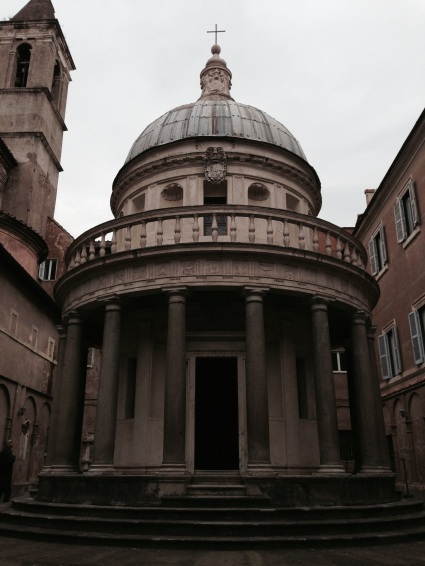When it comes to churches, the city of Rome has plenty to offer – more than 900 in fact. They make an important stop for any Art appreciator as these churches often hold key works by famous Old Masters (such as Raphael, Michelangelo, and Caravaggio), usually displayed in the setting they were originally intended for. What’s more, visitors typically don’t have to pay an entrance fee – although some do charge a euro or two to turn on a timed light to better illuminate their main attractions. While their sheer number can be a dream for any church enthusiast, it can also prove to be a nightmare when planning your ecclesiastical itinerary through Rome. No one wants to risk a round of ‘church roulette’ only to be left with the memory of an uninspiring and disappointing experience. To help you plan your upcoming trip to the “Eternal City”, I have some suggestions here of Roman churches that are well worth a visit.
Chiesa di Sant’Ignazio, Campo Marzio, http://www.chiesasantignazio.it
This is one of my favourite churches in Rome. It is dedicated to Saint Ignatius Loyola, the founder of the Jesuit Order, and is decorated in an extremely Baroque style. What keeps me coming back to this particular church is the incredible and grandiose fresco painting running down the ceiling of the nave. It was painted by Andrea del Pozzo in the 1680’s and is a brilliant example of the seventeenth century interest in optical illusion (‘trompe l’œil’). Make sure you stand on the circular brass plate, implanted in the floor of the nave, to get the best view of Pozzo’s fresco. There’s also another plate on the floor, just before the church crossing. This marks the ideal position from which to see the ‘trompe l’œil’ domed ceiling – if you look closely you will notice that it is actually a flat surface and not a dome at all!
Chiesa del’Gesù, http://www.chiesadelgesu.org
This is the central, “Mother Church” of the Jesuit Order, and is conveniently just around the corner from the Chiesa di Sant’Ignazio. It was consecrated in 1584 and boasts some dramatic ceiling fresco paintings and more ‘trompe l’œil’. Although Michelangelo had originally offered to design the church for free, the patron (Cardinal Alessandro Farnese) ultimately chose to commission the services of Barozzi da Vignola, the Farnese family architect. When visiting this church, don’t miss the St. Ignatius Chapel on the left side of the transept, designed in the last years of the seventeenth century by Andrea del Pozzo. In the presbytery, beyond the choir, you will also find a portrait bust of Cardinal Robert Bellarmine by Gian Lorenzo Bernini, who was said to have worshiped in this church on a daily basis.
Il Tempietto, Piazza di San Pietro in Montorio, http://www.sanpietroinmontorio.it
The Tempietto is actually a small chapel found in the courtyard of San Pietro in Montorio. Designed by the architect Donato Bramante in 1502 to commemorate the alleged place that Saint Peter was crucified, it is regarded as the prime example of High Renaissance architecture. This breathtaking chapel is located on the other side of the Tiber river, so a relaxing, scenic walk through the Trastevere district of the city can definitely be tied in as well.
Santa Maria del Popolo, Piazza del Popolo
This small church just outside the Borghese gardens in the Lazio district of Rome, houses works by a number of big names – Raphael, Bernini, and Caravaggio, just to name a few. The main attraction here is the Cersai Chapel, found to the left of the altar. It holds two of Caravaggio’s most well known paintings, as well as an altarpiece by Annibale Caracci, the poster boy painter of the Baroque period. Then to the left of the nave there’s the Chigi Chapel, designed and decorated by Raphael and later by Gian Lorenzo Bernini. It is a melting pot of Renaissance and Baroque artworks and should also not be missed.
San Luigi dei Francesi, Piazza di San Luigi dei Francesi, http://saintlouis-rome.net

The Caravaggio paintings in The Contarelli Chapel. From Left to Right: ‘The Calling of Saint Matthew’, ‘Saint Matthew and the Angel’, and ‘The Martyrdom of Saint Matthew’, c. 1600, oil on canvas.
If you’re still riding on that Caravaggio high from Santa Maria del Popolo, then I suggest heading over to San Luigi dei Francesi to see the Contarelli chapel. Not only does this church hold a series of Caravaggio paintings depicting the life of Saint Matthew, but it also has works by Domenichino and Cavalier d’Arpino. When looking in on the Contarelli chapel, make note of Caravaggio’s use of light in the three paintings – he has lit the compositions according to the natural sun light streaming in from the tiny window above!
Santa Maria Sopra Minerva, Piazza della Minerva, http://www.basilicaminerva.it
This church is located around the side of the Pantheon and is modeled on the Church of Santa Maria Novella in Florence. Outside, in the Piazza della Minerva, stands Gian Lorenzo Bernini’s famous little elephant, which holds up one of Rome’s eleven Egyptian obelisks. The interior boasts a beautifully decorated blue ceiling running above the nave, as well as Michelangelo’s statue of Christ the Redeemer, who stands near the main altar, and a fresco cycle by the Renaissance artist Filippino Lippi. Many popes were entombed here, such as the two Medici popes, Leo X and Clement VII, and you will also the tombs of Saint Catherine of Siena and the Renaissance artist Fra Angelico, who died in Rome.
And finally, there’s always Saint Peter’s Basilica, rammed full of incredible works of art and an absolute must for any visit to Rome. Be sure to beat the queues and crowds by going early morning, it really makes the experience a lot less stressful.
This post was originally written for Visit Rentals.





